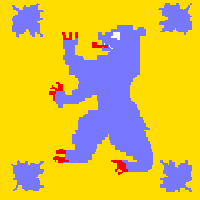
Well as I more-or-less as expected, the initial turn of the Afristan Campaign did not result in any battles but dissatisfaction seems to be growing around the island and fighting may soon result.
Following are brief accounts from each of the Valley Commands:
Cango River:Captain Davidson lead his full command west into the rich farmlands of the Anwaki people. They received a rather sullen response as they moved from village to village. The women hiding behind their veils and all encompassing clothing seemed to be fearful of the Scots in their kilts.
Sadly on the night of January 22, Sepoy Japjot (#6) of the 2nd PFF (Punjabi Field Force) snuck out at night after telling his mates that he was going to "have some fun". His body was found the following day with his throat cut . . . but there was no indication of who had done this . . . and the investigation was fruitless.
A few days later word of troubles at the Jadu Trading Post reached them and so they left Anwak short one sepoy.
Tyger River:Leaving the veldt of Nukar, Captain Webley-Grant's crossed the Tyger from the port of Belhi into the lush jungles of M'wez. Fortuately they were rather well received by the black heathens who inhabit these lands. Indeed they were feasted at every village that they visited. It is hoped that all of their patrols will be as pleasant.
Vile River:Captain McMurdock lead his command west from Kyro along the north bank of the Vile until he was able to cross into the Ghilz hills. The dark-eyed swarthy folk of those hills were mostly apathetic toward the Field Force.
Unfortunately Ghurka Thapa (#2) was severely incapacitated after being bitten by a viper. The snake was only about two feet long, but there is much doubt as to whether he will survive until he reaches the care of Surgeon Cranbrook back in Kyro.
Wazu River:Evaluating the problems in Baqqar, Ngoon and Fuziwa, Captain Ellis decided to split his forces. He would take the Black Watch and Gurkhas into Baqqar; while Lt. Jeffers would lead the 72nd and Ludhiana Sikhs south into Ngoon, with both planning to meet up the following month in Fuziwa.
Capt. Ellis lead his troops southeast until he could cross the Wazu into the fertile fields of Baqqar. In general the natives were standoffish and fairly apathetic to their presence. The only notable incident occurred when Sepoy Chand (#6) sprained his left ankle so badly that he has to ride on one of the supply mules (resulting in many crude comments from his fellows).
At the same time Lt. Jeffers marched south to Vart, where his troops crossed into the jungles of Ngoon. The black devils who inhabit that jungle territory were not pleased with their presence. A very cold, hostile reception was met with in almost every village. The elders at those villages received them with scant hospitality but a few demonstration of the efficacy of modern firearms tended to somewhat dampen their animosity.
Sadly Private Paul McArthur of the 72nd was critically injured when he was mauled by a jungle cat. Even if he should recover he will forever speak with a high voice and will forever go without heirs.
Reinforcements Choice:All commands will get some reinforcements delivered to their home ports. Each player will have his choice of one of the following options:
- one Cavalryman and one "Briton";
- one Cavalryman and two Sepoys;
- two "Britons" and a Sepoy;
- one "Briton" and three Sepoys;
- or five Sepoys
Please let me know which option you will select.
Finally, the February Situation will appear soon.
-- Jeff
 I wish to clarify something. The placement of your Field Force symbol within a District does NOT indicate its actual position.
I wish to clarify something. The placement of your Field Force symbol within a District does NOT indicate its actual position.









